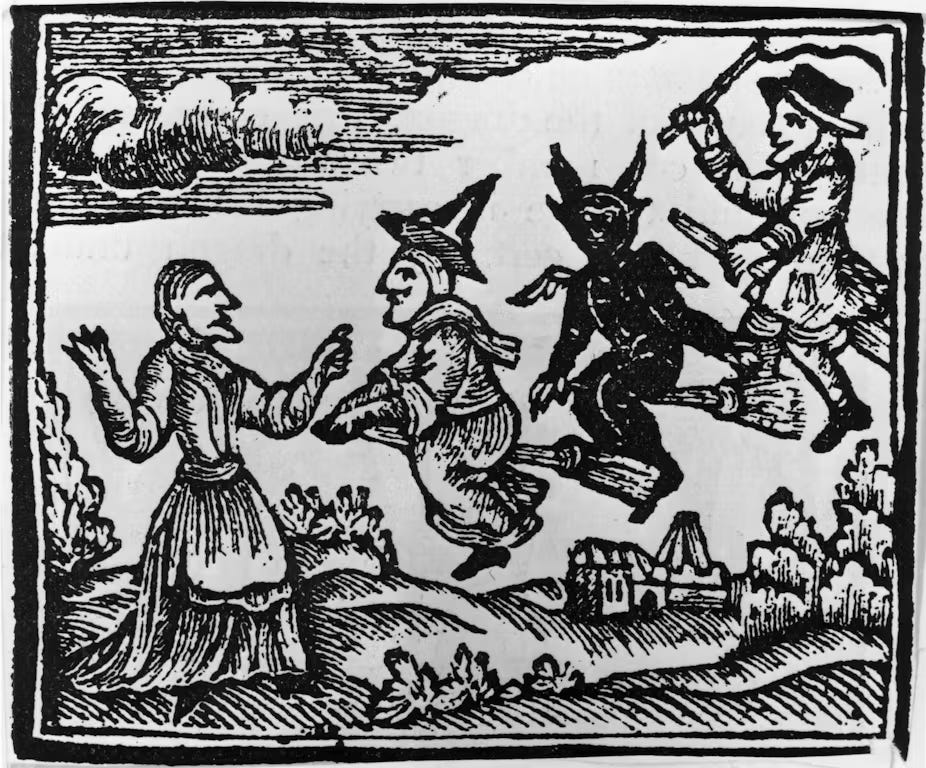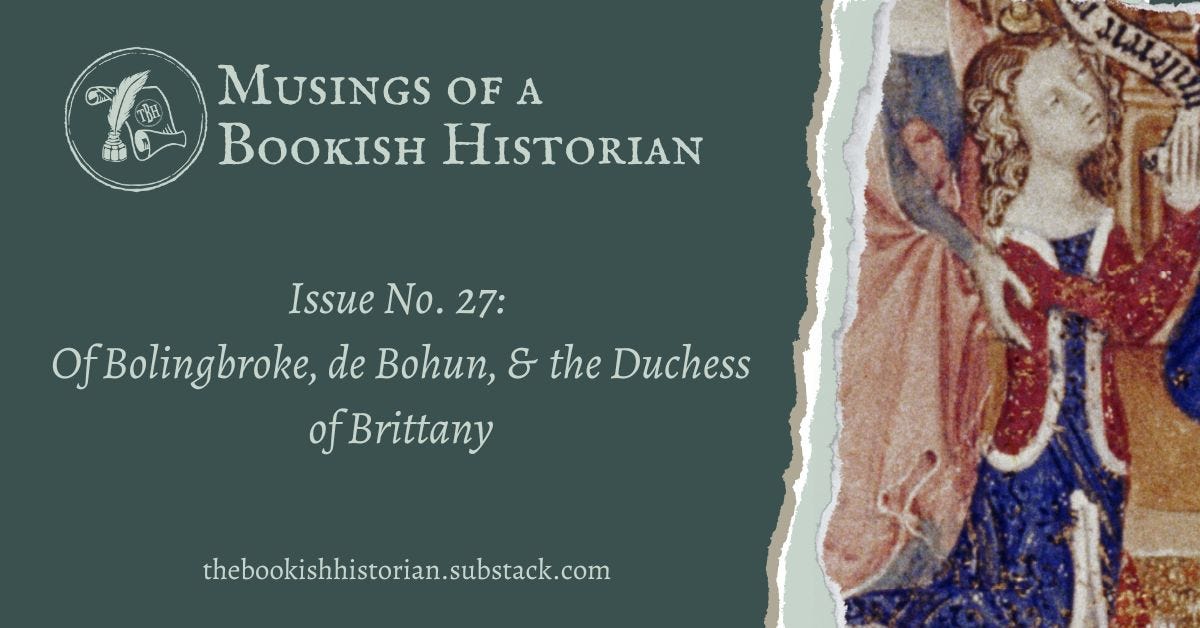Issue No. 27: Of Bolingbroke, de Bohun, & the Duchess of Brittany
A queen accused of witchcraft, a how-to psalter of how to be a good wife, and cross-Channel love
(Some email providers may truncate this post due to its length. For the full experience, please download the Substack app!)
Henry’s two wives - Mary de Bohun and Joan of Navarre - deserve more attention paid to their lives, despite, and in light of their, association with their mighty husband.
Henry Bolingbroke (in my mind, he’s now known as Boring Bloke - don’t ask me why, please. I don’t think he’s actually boring) occupies a fascinating place in medieval history. Like several of his predecessors, he ascended the English throne after overthrowing his cousin Richard II in 1399.
Henry IV bears the distinction of being the first English king to swear his oath in the English language instead of Anglo-Norman since the Norman invasion of 1066.1 Furthermore, he, as Chris Given remarks, “restored a consensual style of politics to England” and was a patron of music, illuminated manuscripts, and more.2 And, finally - and perhaps arguably his greatest legacy - was his son Henry of Monmouth, later Henry V.
But what about his wives? How do they figure into his story? Henry’s two wives - Mary de Bohun and Joan of Navarre - deserve more attention paid to their lives, despite, and in light of their, association with their mighty husband. It’s my hope to shed some light on these lesser-known queens and almost-queens of England.
Suggested Reading: Women in England in the Middle Ages by Jennifer Ward
Related Artifact: The Psalter of Mary de Bohun and Henry Bolingbroke
The Tales of a Queen and Almost-Queen
Mary de Bohun
Little verifiable information exists about Henry IV’s first wife, Mary de Bohun. Born around 1369/1370, she was the daughter of Humphrey de Bohun, 7th Earl of Hertford, and Joan FitzAlan. Mary descended from royalty - she counted both Edward I and Henry III in her patrilineal and matrilineal lines respectively. The de Bohun family itself originated from Normandy and exhibited considerable influence and power in medieval England.
Unfortunately for the earl - in a time of primogeniture descent - he had only two daughters: Eleanor, who later became Duchess of Gloucester, and Mary. As a result, their inheritances would fall into the hands of his daughter’s husbands upon his death. When Humphrey died in 1373, Eleanor and Mary ultimately became the wards of Thomas of Woodstock, the youngest son of King Edward III and Queen Philippa of Hainault.

Thomas married Eleanor in 1376. According to Jean Froissart in his Chronicles,
He [Thomas] took on himself the tutelage of his sister-in-law, and had her instructed in doctrine; for it was his intention she should be professed a nun of the order of St. Clare, which had a very rich and large convent in England…The young lady seemed to incline to their doctrine, and thought not of marriage.3
The plan, then, would be for the de Bohun inheritance to fall solely within Thomas’s possession. However, Thomas’s older brother, John of Gaunt, had other plans.
Duke John…being a prudent and wise man, foresaw the advantage of marrying his only son Henry [Bolingbroke]…to the Lady Mary…The duke had for some time considered he could not choose a more desirable wife for his son than the lady who was intended for a nun, as her estates were very large, and her birth suitable to any rank.4
On February 5, 1381, Mary wed Henry Bolingbroke at Arundel Castle. Their first child, Henry of Monmouth, was born on September 16, 1386. They would go on to have five more children: Thomas, Duke of Clarence; John, Duke of Bedford; Humphrey, Duke of Gloucester; Blanche of England, Electress Palatine; and Philippa of England, Queen of Denmark, Sweden, and Norway.
Sadly, Mary died while giving birth to Philippa at Peterborough Castle in June/July 1394. She was laid to rest on July 6, 1394, at the Church of the Annunciation of Our Lady of the Newarke, Leicester. Mary never assumed the English throne alongside Bolingbroke. Her son, however, marched his way into the annals of history as Henry V, the hero of Agincourt and one of the most well-regarded English kings.

Joan of Navarre
In researching Joan of Navarre for this issue, I stumbled upon quite a surprising introduction from A.R. Myers:
In the long line of Queens of England, Joan of Navarre, the Queen of Henry IV, is, in most respects, not of outstanding note. In one way, however, she is unique; she is the only Queen of England to be imprisoned for treasons by means of witchcraft.5
Prior to this, Joan of Navarre, daughter of Charles II of Navarre and Joan of Valois, spent her life across the English Channel. Born around 1368/1370, she married John IV, Duke of Brittany, in 1386. Together, they had eight children before John died in 1399.
During a period of banishment from 1398-1399, Henry Bolingbroke resided with the duke and duchess.6 The future king and duchess developed a strong degree of affection for each other.7 After John’s death, Henry and Joan married by proxy in 1402 followed by an official wedding in 1403. It’s said Joan enjoyed warm and amicable relationships with her husband and stepchildren8, so how was a queen subjected to rumors of treason through witchcraft?

Contemporary chronicles claimed that Joan planned to kill Henry V, the new king, through witchcraft.9 Authorities (and rumors) implicated three men of the queen’s household - her confessor, John Randolf, a Franciscan friar; Roger Colles of Shrewsbury; and Peronell Brocart - in the supposed happenings.10 Ironically, Randolf also accused Joan of witchcraft in the first place! Regardless, as a result, Henry had Joan arrested in 1419 and imprisoned for three years.
Household accounts from these years, however, reveal that Joan’s captivity offered her “a degree of consideration unusual in the case of a person charged with treason by means of witchcraft”.11 Expenses during her imprisonment included a wide variety of expensive goods including furs and materials, wine, gold chains and rosaries, food, medicines, and more. Furthermore, Joan maintained a large staff and plentiful flexibility to move between residences at first. Expenditures tightened over time, but Joan still enjoyed a life of plenty.
The question becomes: why was she imprisoned? Myers suggests that both Anti-Breton sentiment and her financial support from the royal government played key roles in her continued imprisonment, long after the cessation of any investigations.12 After all, Joan was not put on trial.
Of particular note is Joan’s dowry. At the time of her marriage to Henry IV, the queen received an annual stipend of 10,000 marks, not an insignificant amount. By keeping Joan imprisoned, the royal government did not have to pay the dowry. The money could be put to other uses instead.
By 1422, Henry regretted his earlier actions and released Joan. Over time, her fortune returned, and she lived in comfort for the rest of her days, retiring to Nottingham Castle. She passed away on June 10, 1437, and rests in Canterbury Cathedral alongside her second husband.
Suggested Reading: Women in England in the Middle Ages by Jennifer Ward
The British historian Jennifer Ward wrote one of the most quintessential books on women in the Middle Ages. It’s well known that women’s roles in the medieval period centered on their roles in the domestic sphere - of wife, mother, caregiver, household manager, and much, much more. Women in England in the Middle Ages, however, provides readers with a much more comprehensive view of the subjects.
Ward effectively breaks down the topic, offering chapters on larger themes such as “Women’s Worlds” and “Marriage”, specific echelons like “Noblewomen” and “Queens”, and spheres such as “Work” and “Religious Women”.
I have not had the pleasure of scouring Women in England in its entirety. What I can say is that it proved invaluable in the writing of this post as well as offering new interpretations of primary and secondary source material. By examining themes like marriage and the societal expectations placed on women, the book enriches our understanding of figures like Mary and Joan.
Related Artifact: The Psalter of Mary de Bohun and Henry Bolingbroke
The de Bohun family left behind an astonishing number of extant psalter books. To date, 11 remain in existence, spread across various repositories. The one I’m focusing on this week resides in the Bodleian Library at the University of Oxford.

Jill C. Havens graces us with a masterful description of the folio depicting Mary and Christ shown above:
In the lower left-hand corner, the illustrator has depicted a female patron saint, identified by most as Mary Magdalene, and a young woman adoring the Virgin and Child. The young woman is presented as an unmarried virgin with her long, blonde hair unbound and uncovered, flowing over her shoulders and down her back. The clothes she wears reflect her aristocratic status…the woman’s hands are clasped, palms together, and both she and the woman behind her kneel in a position of penitent prayer.13
This particular psalter dates from between 1370 and 1380, just prior to Mary de Bohun’s marriage to Henry Bolingbroke. The psalter served both devotional and dynastic purposes, depending on the person viewing and receiving it. As Havens writes, “the Bodleian Psalter-Hours is simultaneously a precious, personal devotional relic and a tangible, public symbol of their family, wealth, and privilege.”14
Mary’s father Humphrey commissioned a set of psalters to celebrate her marriage to Henry. The psalters not only commemorate the marriage but also serve to remind Mary of her God-given duties as a daughter and wife - that of bearing heirs, continuing the royal line, and emphasizing her family’s place of power and authority.
Finally, this artifact serves as a reminder of Mary’s contributions to the royal lineage, despite her never holding the title of queen.
Artifact Description
Title: Bohun Psalter and Hours
Date: c. 1370-1380
Material: Parchment
Place of Origin: England
Collection: Bodleian Library, University of Oxford
Featured image: Donor portrait of Mary de Bohun with Mary Magdalene, the Virgin Mary and Christ-child in the Bohun Psalter and Hours (©University of Oxford, Bodleian Library, MS Auct. D. 4. 4, fol. 181v)
For more information on the language transition, check out Jessica Carey-Bunning’s article on the subject.
Chris Given-Wilson, “Remembering the Reign of Henry IV,” Yale University Press, https://yalebooks.yale.edu/2016/06/07/remembering-the-reign-of-henry-iv/.
The translation of Froissart’s Chronicles comes from Jennifer Ward, Women of the English Nobility and Gentry, 1066-1500 (Manchester, UK: Manchester University Press, 1995), 21.
Ibid., 21.
Alexander Reginald Myers, 1913-1980, Author, and Henry Guppy, 1861-1948, Editor, “The Captivity of a Royal Witch: The Household Accounts of Queen Joan of Navarre, 1419-21,” Bulletin of the John Rylands Library, Manchester 24, no.2 (1940), 263, https://jstor.org/stable/community.28211344.
Richard II banished Henry and another lord, Thomas Mowbray, Duke of Norfolk, due to a quarrel.
"Joan of Navarre." Encyclopedia Britannica, July 5, 2024, https://www.britannica.com/biography/Joan-of-Navarre.
Myers, “The Captivity of a Royal Witch,” 263-264.
Jennifer Ward, Women in England in the Middle Ages (London: Hambledon Continuum, 2006), 141.
Myers, “The Captivity of a Royal Witch,” 264-265.
Ibid., 271.
Ibid., 274-275.
Jill C. Havens, “A Gift, a Mirror, a Memorial: The Psalter-Hours of Mary de Bohun,” in Medieval Women and Their Objects, edited by Jenny Adams and Nancy Mason Bradbury (Ann Arbor, MI: University of Michigan Press, 2017), 144, http://www.jstor.org/stable/10.3998/mpub.9222733.11.
Ibid., 144.







